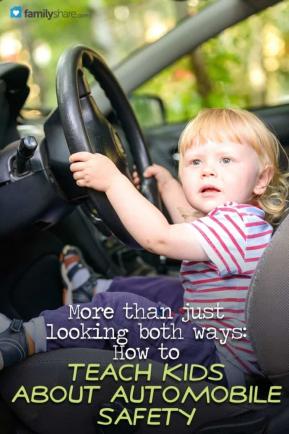
Sometime between being strapped in the infant car seat and sitting in the driver's seat, your children will need to learn about how to be safe in and around cars. Between these two stages, children become mobile enough to move around on their own, sit themselves in their booster seat or chair, roll down windows, use door handles, and unlock locks. Safety quickly becomes a vital lesson for your children to learn.
Always hold hands when crossing streets
You can start teaching children about car safety when they're old enough to walk. This is when the worry begins that if a caregiver gets distracted, the baby will wander out into the street. At this time, you should get in the habit of always having your child hold your hand when you're near a driveway, parking lot, or roadway. As children age, you can start pointing out that cars can go fast and might not see little kids, which is why they must never walk toward or near the street unattended. Part of this education process might include letting your child honk the car horn so he can recognize it when he hears it.
Lock the doors and roll up the windows
While your child is growing, it might be a good idea to have child safety locks on your car doors so your children don't open the doors accidentally. However, you must still be sure to teach them about when the appropriate time is to touch the door handle so that when you stop using the child safety locks your children won't open the door without meaning to. Whether you have child safety locks or not, be sure to instill in your child the idea that when the car is moving, she must never play with the door or roll down the window without your consent. Some cars have a safety feature that prevents the back window from rolling down completely, which can keep little arms from throwing precious toys out the window.
Use the correct car seat
Seatbelts are a very important factor to consider with child safety. The National Highway Traffic Safety Administration has established guidelines to help parents know when to switch children from one car seat to another. They emphasize the importance of keeping children in a rear-facing car seat until they reach 20 pounds and are a year old - notice the child needs to meet both of those conditions. They should be in a forward-facing car seat until they are at least 40 pounds, at which time they can move to a booster seat which they should use until age 8. Children under the age of 12 should not sit in the front passenger seat. Younger children have been injured and even killed when the front passenger-seat airbag opens. To encourage consistent seatbelt wear, make sure the belt fits the child well and set a good example by wearing yours, too.
Teach how to care for the car
You can start to instill in children the value of a car by letting them help you care for it. When they're very little, let them pretend to vacuum the interior with a plastic vacuum or wipe the outside with a clean, soft cloth. As they get older, they can take a more active role in the care and maintenance of the car. This early emphasis on the need to take good care of the car will help them keep that habit when they get old enough to drive it.
Your children are the most precious contents your car will ever carry. As the vessel of those priceless gems, make sure to keep it in good condition, install the car seats correctly, address maintenance issues promptly as they arise, and always drive carefully and cautiously.

